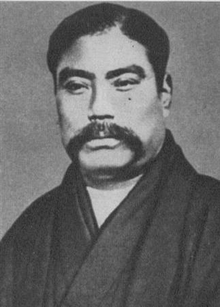The Origin of Mistubishi
The founder of the Mitsubishi business group of Japan is officially Yatro Iwasaki (1835-1885).
He was a son of a samurai of the Tosa han (a han is a semi-autonomous territory of a feudal samurai lord subject to Tokugawa shogun who governed the whole Japan). Iwasaki himself served as a samurai under the Yamaguchi clan, whose head was the lord of Tosa (presently Kochi Prefecture). Young samurai Iwasaki worked as a kind of intelligence officer, since the era at the time was moving to a civil war of Japan between the Tokugawa shogun and anti-Tougawa samurai camp, which eventually resulted in the Meiji Restoration of the Imperial Authority.
The Tosa han led by the Yamaguchi clan was a kind of neutral between the Tokugawa camp and the anti-Tokugawa camp. But it was also eager to enrich its financial state and strengthen its influence in the turbulent politics of Japan that was going to be split up by pro-Tokugawa hans supporting the rule by the samurai shogun from the Tokugawa clan and anti-Tokugawa hans led by the Chosyu and Satsuma hans. Major hans, along with the Tokugawa clan, were trying to enrich their economy through trade mainly with Western countries, since the Tokugawa administration abolished the close-door policy, which had lasted since the early 17th century, in 1850s.
Against this background, samurai Iwasaki was sent to Nagasaki, a big port city in western Japan that was getting a major trade center for Japan at the time. Merchants from Europe and America launching trading business with Japan were mainly based on Nagasaki that had been the only designated port open to limited trade partners, specifically Portugal and China, of the Tokugawa regime with the closed-door policy. Iwasaki was ordered to help trade activities of the Tosa han led by Sakamoto Ryuma who was working as an active business and political middleman between the major anti-Tokugawa hans of Chosyu and Satsuma, though Sakamoto was originally from the Tosa han.
Sakamoto was a kind of revolutionary samurai. He had established a strong tie with a British merchant to import thousands or more rifles and other weapons as well as ships. Sakamoto also operated a merchant ship from his business base in Nagasaki. His business activities were authorized by the Tosa han, and Iwasaki came to Nagaski to join Sakamoto Ryuma. Later or after the Meiji Restoration in 1868, Yataro Iwasaki came to operate his own maritime company, which was virtually an extension of Sakamoto's business. And Iwasaki's maritime business has never ceased to grow in subsequent centuries to date, which is now known as the Mistubishi business group in the world.
However, Sakamoto Ryuma, a kind of Iwasaki's benefator, could not survive to live in the Meiji era that started with the fall of the Tokugawa samurai regime.
One day Sakamoto left Nagasaki and Iwasaki, heading for Kyoto after arranging purchase or selling of 3,000 rifles to the Tosa han. In Kyoto where at the time shogun Tokugawa Yoshinobu was stationed, Sakamoto contributed to Yoshinobu's decision to concede, though nominally, the administrative power to the imperial court supported by anti-Tokugawa samurais. It was a big historic incident, and for this reason, Sakamoto Ryuma is described in history text books in Japan as one of the greatest heroes of the Meiji Restoration. But, several weeks later, Sakamoto was assassinated in Kyoto by samurais under the authority of shogun Yoshinobu, though it is still a mystery who had actually issued an order of the assassination of Ryuma who was widely known as one of key figures in the tense situation before the civil war that would start around Kyoto several weeks later after Sakamoto's death.
It is not clear how Yataro Iwasaki felt when he heard that Sakamoto Ryuma was assassinated. But it is known that after the assassination of Sakamoto, Iwasaki was remarkably promoted by leaders of the Tosa han to take control of Tosa han's trade business as if succeeding Sakamoto, which later led to the establishment of Iwasaki's own maritime business.
Incidentally, the Tosa han joined the anti-Tokugawa camp to fight Tokugawa troops. They became a part of winners of the civil war. Ex-Tosa samurais took higher positions in the new Meiji Government. Iwasaki's business was steadily expanding after the Meiji Restoration, though there were some challenges waiting for the future great Mistsubishi Corporation.
Put simply, the origin of Mitsubishi was the assassinated samurai Sakamoto Ryuma rather than Yataro Iwasaki.
Joh 12:24 Verily, verily, I say unto you, Except a corn of wheat fall into the ground and die, it abideth alone: but if it die, it bringeth forth much fruit.

Yataro Iwasaki
https://en.wikipedia.org/wiki/Iwasaki_Yatar%C5%8D

Sakamoto Ryuma
https://en.wikipedia.org/wiki/Sakamoto_Ry%C5%8Dma
**** **** ****
Mar 8:15 And he charged them, saying, Take heed, beware of the leaven of the Pharisees, and of the leaven of Herod.
Mar 8:16 And they reasoned among themselves, saying, It is because we have no bread.
Mar 8:17 And when Jesus knew it, he saith unto them, Why reason ye, because ye have no bread? perceive ye not yet, neither understand? have ye your heart yet hardened?
